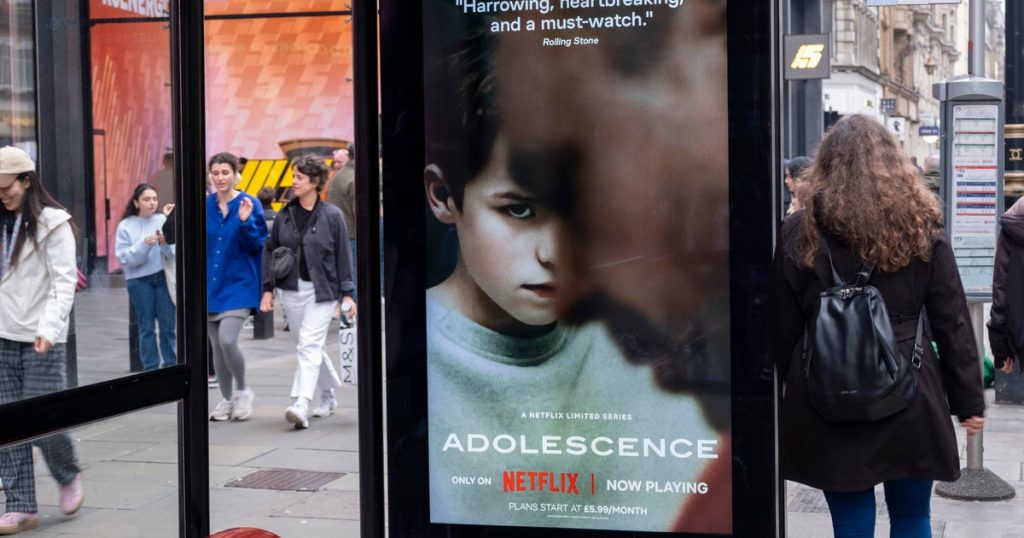Netflix’s “Adolescence” has captured the attention of audiences in the U.K., quickly becoming the streaming service’s most-watched drama in the region. With over 120 million views globally, the series addresses the disturbing themes of radicalization and misogyny in the digital age, resonating with both viewers and policymakers. The show has sparked national conversations, prompting initiatives aimed at educating youth about the dangers posed by violent online content.
| Article Subheadings |
|---|
| 1) Overview of “Adolescence” and Its Impact |
| 2) A Glimpse into the Online World |
| 3) Response from Political Leadership |
| 4) Education Initiatives Inspired by the Show |
| 5) The Importance of Conversations on Misogyny |
Overview of “Adolescence” and Its Impact
“Adolescence,” a groundbreaking drama by Netflix, has set a new standard for storytelling on streaming platforms. The show’s narrative revolves around a 13-year-old boy, Jamie, who becomes embroiled in a tragic incident. Accused of murder, Jamie’s actions serve as a horrifying case study illuminating the darker side of online influences. The series, marked by its gritty portrayal of the consequences of radicalized, misogynistic views, has sparked significant discussions among viewers and commentators alike. With over 120 million views, it’s no surprise that “Adolescence” has become a focal point in dialogues about youth behavior and societal issues, illustrating the urgent need to address these themes in contemporary settings.
A Glimpse into the Online World
The character of Jamie offers a lens into a world few parents recognize, presenting a narrative that foregrounds the pervasive negative influences of online communities. Following a series of events that lead to his tragic actions, Jamie’s backstory reveals a troubling connection to the incel movement, where he was targeted and labeled as an “incel” by a female classmate. This term, short for “involuntary celibate,” represents a community often associated with toxic masculinity and misogyny. Through Jamie’s experiences, the show effectively highlights the risks of social media, where harmful ideologies can take root. The impact of this portrayal is crucial for understanding how these communities shape young minds, especially in an increasingly digital landscape.
Response from Political Leadership
The ramifications of “Adolescence” have not gone unnoticed in political corridors. U.K. Prime Minister Keir Starmer, during a recent roundtable discussion, expressed his personal connection to the show’s themes as a parent. He indicated that addressing the issues raised by the series requires more than just legislative measures; it calls for comprehensive societal engagement. He stated,
“This isn’t a challenge politicians can simply legislate for. Believe me, if I could pull a lever to solve it, I would. Only by listening and learning from the experiences of young people and charities can we tackle the issues this groundbreaking show raises.”
His remarks suggest an acknowledgment of the complexities involved in navigating the issues of online radicalization and misogyny.
Education Initiatives Inspired by the Show
In light of the conversations initiated by “Adolescence,” educational efforts are now underway aimed at fostering understanding of misogyny and online radicalization among school-aged children. Starmer announced that Netflix would allow high schools access to the show for free, positioning it as a valuable educational tool. This move reflects an attempt to equip students with the skills necessary to critically assess their online experiences. Organizations like the charity Tender are also stepping up, creating workshops tailored for children aged 9 to 11. These workshops focus on teaching young individuals to recognize controlling behaviors and understand concepts such as “gaslighting” through interactive exercises, including the use of scripts and games.
The Importance of Conversations on Misogyny
The dialogue spurred by “Adolescence” underscores the urgent need for ongoing discussions around misogyny and its implications. Experts assert that shining a spotlight on these issues has been long overdue. Susie McDonald, CEO of the charity Tender, pointed out the necessity of empowering children to navigate harmful material critically. She emphasized,
“We have to protect our children by enabling them to be able to look at material if it comes their way and be able to critically assess, ‘Is that something that I should be looking at?’
By involving both boys and girls in these conversations, society can foster a more equitable understanding of relationships.
| No. | Key Points |
|---|---|
| 1 | “Adolescence” has become Netflix’s most popular U.K. drama with over 120 million views. |
| 2 | The show reveals the dangers of online radicalization among youth. |
| 3 | U.K. Prime Minister Keir Starmer highlighted the need for a societal response. |
| 4 | Netflix will provide schools with free access to the series as an educational tool. |
| 5 | Experts urge the necessity of conversations around misogyny and the role of education. |
Summary
The impact of Netflix’s “Adolescence” extends far beyond mere entertainment; it has ignited essential conversations regarding misogyny and online radicalization, prompting educational initiatives and political engagement. By providing a hard-hitting narrative that resonates with both youth and adults, the series has become a pivotal tool for understanding the dangers posed by digital communities. The collective will to address these issues is a crucial step towards fostering healthy relationships in contemporary society.
Frequently Asked Questions
Question: What themes does “Adolescence” explore?
“Adolescence” explores themes of radicalization, misogyny, and the negative influences of online communities on youth.
Question: How has the political leadership responded to the series?
U.K. Prime Minister Keir Starmer has acknowledged the series’ impact and emphasized the need for societal engagement to tackle the issues it raises.
Question: What initiatives are being implemented in schools following the show’s success?
Schools are being offered free access to “Adolescence” as an educational resource, while workshops are being held to teach children about recognizing and navigating toxic behaviors.


